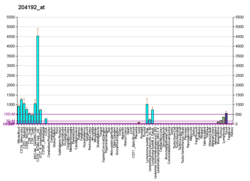Lökosit Antijeni CD37, insanlarda CD37 geni tarafından kodlanan bir proteindir.[4][5]
Bu protein, tetraspanin ailesi olarak da bilinen transmembran 4 süperailesinin üyesi olan bu gen tarafından kodlanmıştır Bunun üyelerinin çoğu, dört hidrofobik transmembran etki alanının varlığı aracılığıyla ayırt edici nitelikte olan hücre yüzey proteinleridir. Tetraspaninler, bağışık yanıtların, hücre gelişiminin, etkinleşmenin, büyümenin ve hareketliliğin düzenlenmesinde rol oynayan mediate sinyal iletim olaylarına aracılık etmektedir.[6][7][8][9] CD37'nin dışa vurumu (ekspresyonu), olgun B hücrelerinin bolluğunda bağışıklık sistemi hücreleriyle kısıtlanmıştır ve T hücreleri ile miyeloid hücrelerde daha düşük ekspresyonu olduğu saptanmıştır. CD37, integrinler ve başka transmembran 4 süperailesi proteinleriyle kompleks yaptığı bilinen hücre yüzey glikoproteinidir. Alternatif uçbirleştirme (alternatif splicing), farklı izoformları kodlayan çoklu transkript türevleri ile sonuçlanır.[5] CD37, hümoral[10][11] ve hücresel bağışık yanıtlarının ikisini de kontrol eder.[12][13][14] Farelerde CD37 eksikliği, B hücreli lenfomaların spontan olarak gelişmesine öncülük eder[15] ve CD37 negatif lenfomalı hastaların daha kötü bir klinik gidişi bulunmaktadır.[16]
- ^ a b c GRCh38: Ensembl release 89: ENSG00000104894 - Ensembl, May 2017
- ^ "İnsan PubMed Başvurusu:". National Center for Biotechnology Information, U.S. National Library of Medicine.
- ^ "Fare PubMed Başvurusu:". National Center for Biotechnology Information, U.S. National Library of Medicine.
- ^ "The genes for CD37, CD53, and R2, all members of a novel gene family, are located on different chromosomes". Immunogenetics. 37 (6). Mar 1993. ss. 461-5.
- ^ a b "Entrez Gene: CD37 CD37 molecule". 5 Aralık 2010 tarihinde kaynağından arşivlendi.
- ^ "The tetraspanin web modulates immune-signalling complexes". Nature Reviews. Immunology. 5 (2). Şubat 2005. ss. 136-48.
- ^ "Lateral organization of membrane proteins: tetraspanins spin their web". The Biochemical Journal. 420 (2). Mayıs 2009. ss. 133-54.
- ^ "Tetraspanin functions and associated microdomains". Nature Reviews Molecular Cell Biology. 6 (10). Ekim 2005. ss. 801-11.
- ^ "Molecular interactions shaping the tetraspanin web". Biochemical Society Transactions. 45 (3). 15 Haziran 2017. ss. 741-750.
- ^ "The tetraspanin protein CD37 regulates IgA responses and anti-fungal immunity". PLoS Pathogens. 5 (3). Mart 2009. ss. e1000338.
- ^ "The tetraspanin CD37 orchestrates the α(4)β(1) integrin-Akt signaling axis and supports long-lived plasma cell survival". Science Signaling. 5 (250). Kasım 2012. ss. ra82.
- ^ "Targeted inactivation of the tetraspanin CD37 impairs T-cell-dependent B-cell response under suboptimal costimulatory conditions". Molecular and Cellular Biology. 20 (15). Ağustos 2000. ss. 5363-9.
- ^ "A regulatory role for CD37 in T cell proliferation". Journal of Immunology. 172 (5). Mart 2004. ss. 2953-61.
- ^ "Tetraspanins CD37 and CD151 differentially regulate Ag presentation and T-cell co-stimulation by DC". European Journal of Immunology. 39 (1). Ocak 2009. ss. 50-5.
- ^ "Tetraspanin CD37 protects against the development of B cell lymphoma". The Journal of Clinical Investigation. 126 (2). Şubat 2016. ss. 653-66.
- ^ "Assessment of CD37 B-cell antigen and cell of origin significantly improves risk prediction in diffuse large B-cell lymphoma". Blood. 128 (26). Aralık 2016. ss. 3083-3100.
- "Novel structurally distinct family of leucocyte surface glycoproteins including CD9, CD37, CD53 and CD63". FEBS Letters. 288 (1-2). Ağustos 1991. ss. 1-4.
- "Complexes of tetraspanins with integrins: more than meets the eye". Journal of Cell Science. 114 (Pt 23). Aralık 2001. ss. 4143-51.
- "The primary structure of the human leukocyte antigen CD37, a species homologue of the rat MRC OX-44 antigen". The Journal of Experimental Medicine. 172 (3). Eylül 1990. s. 1007.
- "The primary structure of the human leukocyte antigen CD37, a species homologue of the rat MRC OX-44 antigen". The Journal of Experimental Medicine. 169 (4). Nisan 1989. ss. 1497-502.
- "The B cell-associated CD37 antigen (gp40-52). Structure and subcellular expression of an extensively glycosylated glycoprotein". Journal of Immunology. 140 (3). Şubat 1988. ss. 905-14.
- "Association of four antigens of the tetraspans family (CD37, CD53, TAPA-1, and R2/C33) with MHC class II glycoproteins". Immunogenetics. 39 (4). 1994. ss. 249-56.
- "Gene structure, chromosomal localization, and protein sequence of mouse CD53 (Cd53): evidence that the transmembrane 4 superfamily arose by gene duplication". International Immunology. 5 (2). Şubat 1993. ss. 209-16.
- "Selective tetraspan-integrin complexes (CD81/alpha4beta1, CD151/alpha3beta1, CD151/alpha6beta1) under conditions disrupting tetraspan interactions". The Biochemical Journal. 340 (1). Mayıs 1999. ss. 103-11.
- "Expression of tetraspans transmembrane family in the epithelium of the gastrointestinal tract". Journal of Clinical Gastroenterology. 29 (1). Temmuz 1999. ss. 63-7.
- "Functional expression of transmembrane 4 superfamily molecules on human eosinophils". International Archives of Allergy and Immunology. Cilt 120 Suppl 1. 1999. ss. 38-44.
- "A regulatory role for CD37 in T cell proliferation". Journal of Immunology. 172 (5). Mart 2004. ss. 2953-61.
- "Sequence comparison of human and mouse genes reveals a homologous block structure in the promoter regions". Genome Research. 14 (9). Eylül 2004. ss. 1711-8.
- "Dectin-1 interaction with tetraspanin CD37 inhibits IL-6 production". Journal of Immunology. 178 (1). Ocak 2007. ss. 154-62.
- "Targeting CD37-positive lymphoid malignancies with a novel engineered small modular immunopharmaceutical". Blood. 110 (7). Ekim 2007. ss. 2569-77.


